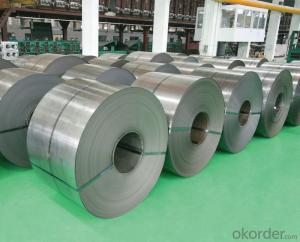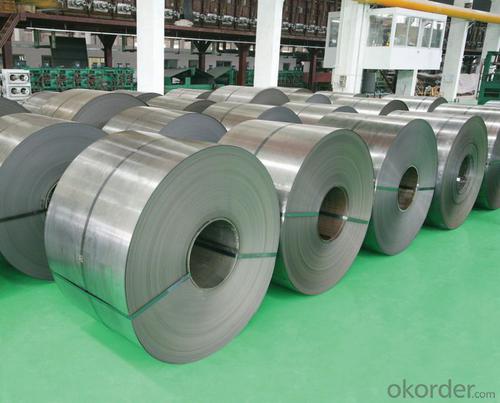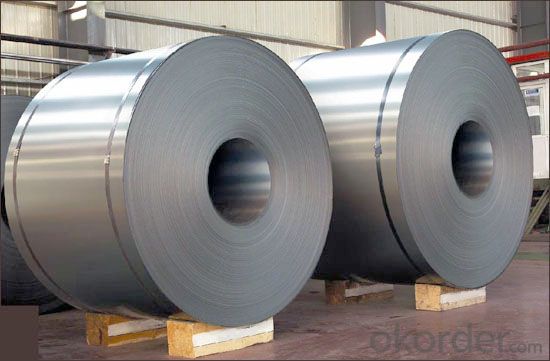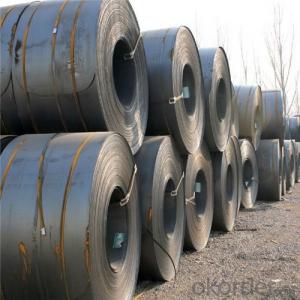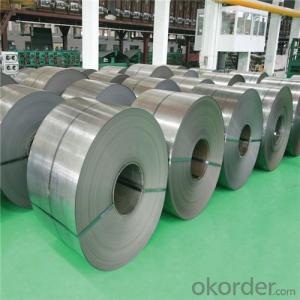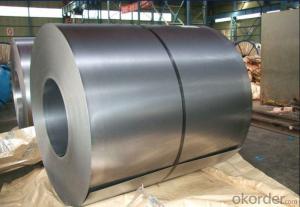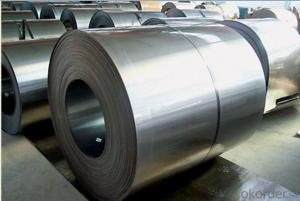COLD ROLLED STEEL COIL WITH HIGH QUALITY AND COMPETITVE PRICE NO.1
- Loading Port:
- Tianjin
- Payment Terms:
- TT OR LC
- Min Order Qty:
- 100 m.t.
- Supply Capability:
- 8000 m.t./month
OKorder Service Pledge
OKorder Financial Service
You Might Also Like
Cold rolled steel is the based material for galvanized steel coil and pre-painted galvanized steel coil. It is widely used in light industry for marking tank, furniture, refrigerators, washers, freezer plate, air conditioner, micro-wave oven, water heater, soot such machine etc.
Main specification:
COLD ROLLED STEEL | |
Thicknenss | 0.10mm-4.00mm |
Width | 600mm-2000mm |
Sheets length | 1200-6000mm |
Coil inner diameter | 508-610mm |
Surface treatement | matt finish/bright finish,oiling/dry, bright anneal/black anneal |
Coil weight | 3-5t |
We can supply customers' with different specifications of the highest quality and lowest price.
Sincerely welcome to contact us for the future details if any item interest you ,and we will make every effort to assure that your requirements will be satisfied ,and we hope to establish long-term business relations with you on the basis of the equality and mutual benefit.
Sincerely welcome to contact us for the future details if any item interest you ,and we will make every effort to assure that your requirements will be satisfied ,and we hope to establish long-term business relations with you on the basis of the equality and mutual benefit.
we are waiting for your email.
- Q: What are the challenges in coil blanking?
- In order to achieve efficient and accurate production, coil blanking, a process used to cut flat metal sheets from coiled stock, must tackle several challenges. Some of the key challenges include: 1. Material variations: Coiled stock can have variations in thickness, width, and surface quality, which can impact the cutting process and result in inconsistent blanks. To ensure consistent quality and dimensional accuracy, it is crucial to carefully select and control the material. 2. Coil set and crossbow: Coiled stock often has inherent shape imperfections like coil set (longitudinal curvature) and crossbow (transverse curvature), which can cause alignment issues during cutting. Minimizing these imperfections requires the use of specialized equipment and techniques, such as straighteners and leveling systems. 3. Coil edge condition: The edges of coiled stock can have burrs, waves, or irregularities, which can affect the quality and precision of the cut blanks. Employing proper edge conditioning techniques, like deburring or edge trimming, is necessary to ensure clean and straight edges. 4. Slitting and shearing forces: The forces exerted during coil blanking can induce stresses and strains in the material, potentially leading to deformation or springback. To minimize these effects and maintain dimensional accuracy, careful consideration of slitting and shearing forces, along with proper tooling design and machine settings, is necessary. 5. Scrap and material waste: Coil blanking can generate significant amounts of scrap material, especially during setup and adjustment phases. Managing scrap and reducing material waste is crucial to optimize production efficiency and minimize costs. Efficient nesting algorithms and real-time monitoring systems can help achieve this. 6. Automation and productivity: Due to market demands, coil blanking often requires high-speed and high-volume production. Enhancing productivity can be achieved through the implementation of automation systems, such as robotic material handling and advanced control systems. However, integrating and synchronizing these components with the cutting process requires careful planning and system integration expertise. Overall, addressing these challenges in coil blanking necessitates proper material selection, advanced equipment, specialized techniques, and efficient process control. By overcoming these challenges, manufacturers can achieve consistent quality, dimensional accuracy, and productivity in coil blanking operations.
- Q: how simple is it to take it scrape steel and recyle it. does annybody know the process . i want to do this but first i need some basic information. as far as i know first to melt the steel and in a furness on high heat and than give the shape that customer wants. how right or wrong am i . i want to start on a very small scale.
- I think the melting point of steel is quite high into the two thousand degree F range. If you don't have something that can generate that heat and handle the molten result, you will find recycling scrap iron/steel to be very difficult. The best way to recycle metals is to find a scrap yard that will pay you by the pound for your collected scraps. From there the metals will go to sites which have the giant machinery required to start those metals into a new life. In short, it is not simple to recycle steel or iron.
- Q: What are the different methods of coil welding for steel coils?
- There are several different methods of coil welding for steel coils, each with its own advantages and disadvantages. Here are some of the most commonly used methods: 1. Resistance Welding: This method involves passing an electric current through the coils to generate heat, which then fuses the two ends together. Resistance welding is a fast and efficient process that produces strong and reliable welds. It is commonly used in industries where high-speed production is required. 2. Arc Welding: Arc welding uses an electric arc between an electrode and the workpiece to create a weld. This method can be further divided into different processes, such as shielded metal arc welding (SMAW), gas metal arc welding (GMAW), and flux-cored arc welding (FCAW). Arc welding provides good penetration and can be used on a wide range of steel coils. 3. Laser Welding: Laser welding utilizes a high-powered laser beam to melt and fuse the two ends of the coils together. This method offers precise control, high welding speeds, and minimal distortion. It is often used in applications where precision and aesthetics are crucial, such as the automotive and electronics industries. 4. Induction Welding: Induction welding involves heating the coils using electromagnetic induction. The heat generated melts the edges, which are then pressed together to form a weld. This method is particularly suitable for thin-gauge steel coils and provides good control over the welding process. 5. High-Frequency Welding: High-frequency welding utilizes high-frequency current to heat and weld the coils together. This method is commonly used for pipes and tubes and offers high production rates and good weld quality. 6. Friction Welding: Friction welding uses the heat generated by rubbing the two ends of the coils together to create a weld. This method is fast, reliable, and produces strong joints. It is often used in applications where high-strength welds are required, such as the automotive and aerospace industries. These are just a few of the different methods of coil welding for steel coils. The choice of method depends on factors such as the type and thickness of the steel, the required weld strength, production speed, and overall project requirements.
- Q: What is the typical weight of a steel coil?
- The typical weight of a steel coil varies widely depending on its size, thickness, and type of steel used. However, a common range for steel coils is between 3 to 25 metric tons.
- Q: I need to know how you rate the hardness of steel any ideas?
- For the backyarder to rate hardness, you do a file test. If a smooth file will not mark the steel, it's around 60+RC (Rockwell C scale). If it will mark it with difficulty, the hardness is probably around 56- 58RC. If it will file easily, it's mild steel or is in annealed form, if it is a hardenable steel.
- Q: How are steel coils used in the production of metal storage systems?
- Steel coils are used in the production of metal storage systems as they can be cut and shaped into various components, such as beams, frames, and shelves. These coils provide the necessary strength and durability required for constructing robust and reliable storage systems.
- Q: I have been thinking of buying a knife that says it has damascus steel. The reason for the question is that many people told me that damascus steel does not exist anymore, and that damascus nowadays is fake. Is this true???
- Well, it depends on what you call fake. Modern Damascus steel is perhaps similar, but it is not what people would call Damascus steel in 1500. It is made to look similar, but structurally it is different. For the most part the specific way of making Damascus steel is lost to history.
- Q: i know theres steel in it but what else?
- Corosion Resistant steel..... It does corrode... just at a slower rate then normal steel.
- Q: Is there any way to melt steel without the intense heat of a blast furnace?
- How To Melt Steel
- Q: So...I'm learning about how steel is made and I'm wondering if there is a more environmentally friendy method. I view it as unfriendly b/c of the oxygen that is injected when the steel is in the blast furnace or electric arc furnace. This oxygen bonds w/ the carbon to produce CO and CO2. THis is necessary to reduce the amount of carbon content to produce harder steels. So what other methods are there that can be used w/o having to end up w/ co and co2? thanks
- From what I understand of it, US steel is better as the steel is more recycled than Canadian, so a lot of that oxygen / CO2 has already taken place compared to working from ore. The second reason US steel is environmentally ahead of Canadian is that US tends to use Electric Arc, while Canadian uses Basic Oxygen, Basic Oxygen uses more energy than electric arc, and I think it also uses more oxygen, but I would suspect that oxygen that it uses is 'waste oxygen' and not converted into Co2 because the Co2 process is limited by the carbon, and steel only has so much carbon.
Send your message to us
COLD ROLLED STEEL COIL WITH HIGH QUALITY AND COMPETITVE PRICE NO.1
- Loading Port:
- Tianjin
- Payment Terms:
- TT OR LC
- Min Order Qty:
- 100 m.t.
- Supply Capability:
- 8000 m.t./month
OKorder Service Pledge
OKorder Financial Service
Similar products
Hot products
Hot Searches
Related keywords
